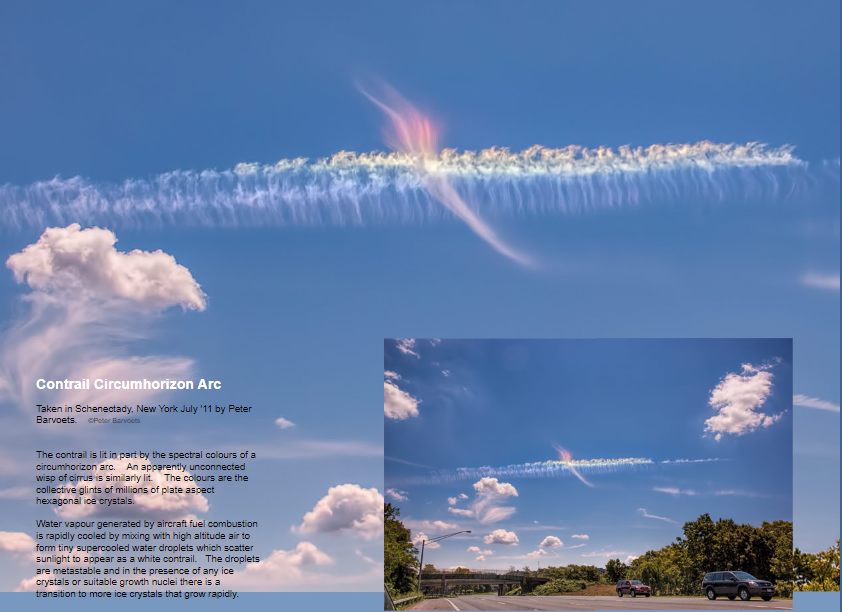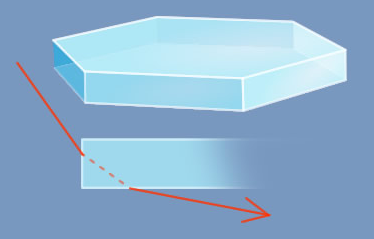Contrail Halo - OPOD
Contrail Halo - OPOD: Exploring the Phenomenon
Contrail halos, also known as circumhorizon arcs, are captivating optical displays that occur when sunlight interacts with the ice crystals present in contrails. While contrails themselves are formed by the condensation of water vapor from aircraft fuel combustion, the presence of ice crystals in the contrail gives rise to these remarkable halos.
Contrails are composed of tiny supercooled water droplets that scatter sunlight, appearing as white streaks in the sky. When ice crystals or suitable growth nuclei are present, these droplets undergo a transition, rapidly transforming into ice crystals themselves. Contrails with a sufficient number of larger ice crystals, typically greater than ~0.05mm across, can refract light cleanly without excessive blurring by diffraction.
In the case of contrail halos, the spectacle is enhanced by the presence of millions of plate aspect hexagonal ice crystals. These crystals collectively create glints of spectral colors, giving the halo its vibrant appearance. The colors we observe in a contrail halo are a result of light being refracted as it enters a plate crystal side face and exits through the lower hexagonal face.
One fascinating aspect of contrail halos is the formation of long tendrils that precipitate out of the contrail. These tendrils consist of large ice crystals that have grown rapidly within the contrail. The conditions within the contrail allow for the formation of these larger crystals, which are essential for creating a well-defined and visually striking halo.
To witness a contrail halo, one must be in the right place at the right time. The halo is typically seen when the sun is high in the sky, around midday or early afternoon. Additionally, it requires specific atmospheric conditions, including the presence of high-altitude cirrus clouds or other suitable growth nuclei. These factors combined create the perfect environment for the formation of contrail halos.
Contrail halos are not limited to a single location but can be observed in various parts of the world. However, due to the specific requirements for their formation, they are relatively rare occurrences. When they do appear, they can captivate onlookers with their stunning colors and intricate patterns.
Photographing a contrail halo can be a rewarding experience for sky enthusiasts. Capturing the vibrant colors and intricate details of these halos requires a keen eye and an understanding of the optimal camera settings. It is advisable to use a wide-angle lens to capture the entire halo, and adjusting the exposure to properly capture the colors is crucial. Additionally, finding a vantage point with an unobstructed view of the sky can help maximize the chances of capturing this awe-inspiring phenomenon.
In conclusion, contrail halos, or circumhorizon arcs, are mesmerizing optical displays that occur when sunlight interacts with ice crystals in contrails. These halos are formed when contrails contain larger ice crystals that refract light cleanly. The resulting spectacle is a vibrant display of spectral colors, captivating those fortunate enough to witness it. While contrail halos are relatively rare, their appearance can be truly awe-inspiring, providing a glimpse into the fascinating world of atmospheric optics.

Contrail Circumhorizon Arc
Taken in Schenectady, New York July '11 by Peter Barvoets. ©Peter Barvoets
The contrail is lit in part by the spectral colours of a circumhorizon arc. An apparently unconnected wisp of cirrus is similarly lit. The colours are the collective glints of millions of plate aspect hexagonal ice crystals.
Water vapour generated by aircraft fuel combustion is rapidly cooled by mixing with high altitude air to form tiny supercooled water droplets which scatter sunlight to appear as a white contrail. The droplets are metastable and in the presence of any ice crystals or suitable growth nuclei there is a transition to more ice crystals that grow rapidly.
Here, large crystals are precipitating out of the contrail in the form of long tendrils. Halos need crystals larger than ~0.05mm across to refract light cleanly without excessive blurring by diffraction. Those falling out of this contrail are much larger.

Circumhorizon arc rays enter a plate crystal side face and leave through the lower hexagonal face
Note: this article has been automatically converted from the old site and may not appear as intended. You can find the original article here.
Reference Atmospheric Optics
If you use any of the definitions, information, or data presented on Atmospheric Optics, please copy the link or reference below to properly credit us as the reference source. Thank you!
-
<a href="https://atoptics.co.uk/blog/contrail-halo-opod/">Contrail Halo - OPOD</a>
-
"Contrail Halo - OPOD". Atmospheric Optics. Accessed on April 23, 2024. https://atoptics.co.uk/blog/contrail-halo-opod/.
-
"Contrail Halo - OPOD". Atmospheric Optics, https://atoptics.co.uk/blog/contrail-halo-opod/. Accessed 23 April, 2024
-
Contrail Halo - OPOD. Atmospheric Optics. Retrieved from https://atoptics.co.uk/blog/contrail-halo-opod/.